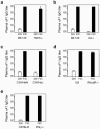Flagellin is an effective adjuvant for immunization against lethal respiratory challenge with Yersinia pestis
- PMID: 16428759
- PMCID: PMC1360354
- DOI: 10.1128/IAI.74.2.1113-1120.2006
Flagellin is an effective adjuvant for immunization against lethal respiratory challenge with Yersinia pestis
Abstract
Gram-negative flagellin, a Toll-like receptor 5 (TLR5) agonist, is a potent inducer of innate immune effectors such as cytokines and nitric oxide. In the lung, flagellin induces a localized and transient innate immune response characterized by neutrophil infiltration and the production of cytokines and chemokines. In view of the extraordinary potency of flagellin as an inducer of innate immunity and the contribution of innate responses to the development of adaptive immunity, we evaluated the efficacy of recombinant Salmonella flagellin as an adjuvant in an acellular plague vaccine. Mice immunized intranasally or intratracheally with the F1 antigen of Yersinia pestis and flagellin exhibited dramatic increases in anti-F1 plasma immunoglobulin G (IgG) titers that remained stable over time. In contrast, control mice had low or undetectable antibody responses. The IgG1/IgG2a ratio of antibody titers against F1 in immunized mice is consistent with a Th2 bias. However, no significant antigen-specific IgE production was detected. Interferons, tumor necrosis factor alpha, and interleukin-6 were not essential for the adjuvant effects of flagellin. Preexisting antiflagellin antibodies had no significant effect on the adjuvant activity of flagellin. Importantly, intranasal immunization with flagellin and the F1 antigen was protective against intranasal challenge with virulent Y. pestis CO92, with 93 to 100% survival of immunized mice. Lastly, vaccination of cynomolgus monkeys with flagellin and a fusion of the F1 and V antigens of Y. pestis induced a robust antigen-specific IgG antibody response.
Figures





References
-
- Akira, S., K. Takeda, and T. Kaisho. 2001. Toll-like receptors: critical proteins linking innate and acquired immunity. Nat. Immunol. 2:675-680. - PubMed
-
- Anderson, G. W., Jr., P. L. Worsham, C. R. Bolt, G. P. Andrews, S. L. Welkos, A. M. Friedlander, and J. P. Burans. 1997. Protection of mice from fatal bubonic and pneumonic plague by passive immunization with monoclonal antibodies against the F1 protein of Yersinia pestis. Am. J. Trop. Med. Hyg. 56:571-573. - PubMed
-
- Andrews, G. P., D. G. Heath, G. W. Anderson, Jr., S. L. Welkos, and A. M. Friedlander. 1996. Fraction 1 capsular antigen (F1) purification from Yersinia pestis CO92 and from an Escherichia coli recombinant strain and efficacy against lethal plague challenge. Infect. Immun. 64:2180-2187. - PMC - PubMed
-
- Banchereau, J., F. Briere, C. Caux, J. Davoust, S. Lebecque, Y.-J. Liu, B. Pulendran, and K. Palucka. 2000. Immunobiology of dendritic cells. Annu. Rev. Immunol. 18:767-811. - PubMed
-
- Ben-Yedidia, T., and R. Arnon. 1998. Effect of pre-existing carrier immunity on the efficacy of synthetic influenza vaccine. Immunol. Lett. 64:9-15. - PubMed
Publication types
MeSH terms
Substances
Grants and funding
LinkOut - more resources
Full Text Sources
Other Literature Sources
Medical

